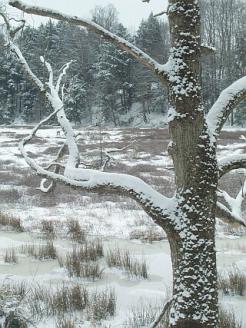Winter Woodland Walk - Flat Rock
When
What
Where
Who
Description
Learn the tricks of identifying trees in the winter, and poke around in the snow to uncover some evergreens. Dress warmly! Meet at CCE at 1PM to carpool.
Report
Winter Woody Plant Walk
On an unusually sunny day for late February, nearly twenty-five people met at the Cornell Cooperative Extension parking lot. Bob Wesley led us on an outing to learn about woodland trees at an area known as Flat Rock, just east of Cornell Plantations. Bob, shown in the center of the picture to the right, gave a few pointers of things to look for when identifying trees and then led the group across partially frozen Fall Creek on a foot bridge which swayed so much it was difficult to cross.
 Near the creek, the floodplain held gravel. Here we saw the sycamore, willow, basswood, and other species that like the rich, wet, floodplain soil. Another species found here was Celtis occidentalis, the common hackberry. When older, this interesting tree sports a coat of deeply furrowed bark as shown in the bottom picture.
Near the creek, the floodplain held gravel. Here we saw the sycamore, willow, basswood, and other species that like the rich, wet, floodplain soil. Another species found here was Celtis occidentalis, the common hackberry. When older, this interesting tree sports a coat of deeply furrowed bark as shown in the bottom picture.
 As we ascended the slope, along a section of the Finger Lakes Trail, we saw oaks, hickories and maples. Besides native plants, Bob pointed out some invasives such as Celastrus orbiculatus, the Eastern Asian bittersweet. This fast-growing vine is listed by the Invasive Plant Council of New York State as one of the top twenty invasives in the state. According to Bob, it grows so quickly and to such size that it can kill trees that it grows on. Another one found that also made the top twenty list is Rhamnus carthartica, common buckthorn, another Eurasian import. Its fruit is eaten by birds and the seeds widely dispersed. Once established, the plant replaces our native wildflowers and changes the characteristics of the community. On the other hand, some our most valued native species are considered to be invasives elsewhere. For example, Prunus serotina, our American black cherry, is considered a real pest in southern Germany and Austria.
As we ascended the slope, along a section of the Finger Lakes Trail, we saw oaks, hickories and maples. Besides native plants, Bob pointed out some invasives such as Celastrus orbiculatus, the Eastern Asian bittersweet. This fast-growing vine is listed by the Invasive Plant Council of New York State as one of the top twenty invasives in the state. According to Bob, it grows so quickly and to such size that it can kill trees that it grows on. Another one found that also made the top twenty list is Rhamnus carthartica, common buckthorn, another Eurasian import. Its fruit is eaten by birds and the seeds widely dispersed. Once established, the plant replaces our native wildflowers and changes the characteristics of the community. On the other hand, some our most valued native species are considered to be invasives elsewhere. For example, Prunus serotina, our American black cherry, is considered a real pest in southern Germany and Austria.
| Latin Name | Common Name |
| Fraxinus americana | White ash |
| Rhamnus cathartica | common buckthorn |
| Rhus hirta | staghorn sumac |
| Ulmus americana | American elm |
| Carya ovata | shagbark hickory |
| Larix decidua | European larch |
| Ulmus pumila | Siberian elm |
| Robinia pseudoacacia | black locust |
| Tilia americana | American basswood (a.k.a. linden) |
| Carya cordiformis | bitternut hickory |
| Prunus serotina | black cherry |
| Fagus grandifolia | American beech |
| Quercus alba | white oak |
| Hamamelis virginiana | American witch hazel |
| Parthenocissus vitacea | woodbine (a.k.a. Virginia creeper |
| Prunus avium | bird cherry (a.k.a. sweet cherry) |
| Salix fragilis | crack willow |
| Carpinus caroliniana | American hornbeam (a.k.a. ironwood, musclewood) |
| Quercus rubra | red oak |
| Carya glabra | pignut hickory |
| Acer rubrum | red maple |
| Acer saccharum | sugar maple |
| Lindera benzoin | Northern spicebush |
| Pinus strobus | Eastern white pine |
| Berberis thunbergii | Japanese barberry |
| Tsuga canadensis | Eastern hemlock |
| Quercus velutina | black oak |
| Amelanchier sp. | shadbush |
| Quercus prinus | chesnut oak (a.k.a. rock oak) |
| Cornus florida | flowering dogwood |
| Celastrus orbiculata | Eastern Asian bittersweet |
| Pinus sylvestris | Scot's pine |
| Cornus alternifolia | alternateleaf dogwood |
| Ostrya virginiana | hophornbeam |
| Populus deltoides | Eastern cottonwood |
| Celtis occidentalis | common hackberry |
| Juniperus virginiana | Eastern red cedar |
| Pinus resinosa | red pine |



